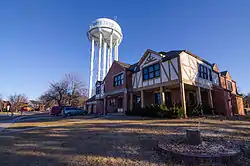Boys Town, Nebraska
Boys Town is a village in Douglas County, Nebraska, United States. The population was 745 at the 2010 census. Boys Town is a suburb of Omaha.
Boys Town, Nebraska | |
|---|---|
 Boys Town water tower | |
 Location of Boys Town, Nebraska | |
| Coordinates: 41°15′41″N 96°7′49″W | |
| Country | United States |
| State | Nebraska |
| County | Douglas |
| Area | |
| • Total | 1.35 sq mi (3.51 km2) |
| • Land | 1.31 sq mi (3.41 km2) |
| • Water | 0.04 sq mi (0.10 km2) |
| Elevation | 1,234 ft (376 m) |
| Population | |
| • Total | 745 |
| • Estimate (2019)[3] | 562 |
| • Density | 427.38/sq mi (165.02/km2) |
| Time zone | UTC-6 (Central (CST)) |
| • Summer (DST) | UTC-5 (CDT) |
| ZIP code | 68010 |
| Area code(s) | 402 |
| FIPS code | 31-06015 |
| GNIS feature ID | 0827609[4] |
| Website | www.boystown.org |
The village of Boys Town was established in 1917 as the headquarters of the Boys Town organization, also known as "Father Flanagan's Boys' Home", founded by Father Edward J. Flanagan.[5] It is dedicated to the care, treatment, and education of at-risk children.
Geography
Boys Town is located at 41°15′39″N 96°7′55″W (41.260901, -96.131882).[6]
According to the United States Census Bureau, the village has a total area of 1.36 square miles (3.52 km2), of which 1.32 square miles (3.42 km2) is land and 0.04 square miles (0.10 km2) is water.[7]
Demographics
| Historical population | |||
|---|---|---|---|
| Census | Pop. | %± | |
| 1940 | 254 | — | |
| 1950 | 975 | 283.9% | |
| 1960 | 997 | 2.3% | |
| 1970 | 989 | −0.8% | |
| 1980 | 622 | −37.1% | |
| 1990 | 794 | 27.7% | |
| 2000 | 818 | 3.0% | |
| 2010 | 745 | −8.9% | |
| 2019 (est.) | 562 | [3] | −24.6% |
| U.S. Decennial Census[8] | |||
2010 census
At the 2010 census there were 745 people, 6 households, and 2 families living in the village. The population density was 564.4 inhabitants per square mile (217.9/km2). There were 15 housing units at an average density of 11.4 per square mile (4.4/km2). The racial makeup of the village was 66.0% White, 26.2% African American, 3.5% Native American, 0.4% Asian, 0.1% Pacific Islander, 1.6% from other races, and 2.1% from two or more races. Hispanic or Latino of any race were 10.1%.[2]
Of the 6 households 16.7% had children under the age of 18 living with them, 33.3% were married couples living together, and 66.7% were non-families. 66.7% of households were one person and 16.7% were one person aged 65 or older. The average household size was 3.17 and the average family size was 3.00.
The median age in the village was 16.7 years. 72.8% of residents were under the age of 18; 10.9% were between the ages of 18 and 24; 13.2% were from 25 to 44; 2.8% were from 45 to 64; and 0.1% were 65 or older. The gender makeup of the village was 57.2% male and 42.8% female.
2000 census
At the 2000 census, there were 818 people, 57 households, and 53 families living in the village. The population density was 589.7 people per square mile (227.2/km2). There were 58 housing units at an average density of 41.8 per square mile (16.1/km2). The racial makeup of the village was 66.01% White, 21.15% African American, 1.34% Native American, 0.49% Asian, 5.01% from other races, and 5.99% from two or more races. Hispanic or Latino of any race were 7.58% of the population.
Of the 57 households 68.4% had children under the age of 18 living with them, 93.0% were married couples living together, and 7.0% were non-families. 7.0% of households were one person and 5.3% were one person aged 65 or older. The average household size was 3.32 and the average family size was 3.47.
The age distribution was 78.9% under the age of 18, 8.9% from 18 to 24, 11.0% from 25 to 44, 0.7% from 45 to 64, and 0.5% 65 or older. The median age was 16 years. For every 100 females, there were 219.5 males. For every 100 females age 18 and over there were 150.7 males.
The median household income was $51,442, and the median family income was $51,944. Males had a median income of $31,563 versus $21,042 for females. The per capita income for the village was $3,048. None of the families and 6.1% of the population were living below the poverty line, including none under 18 and none of those over 64.
References
- "2019 U.S. Gazetteer Files". United States Census Bureau. Retrieved July 26, 2020.
- "U.S. Census website". United States Census Bureau. Retrieved 2012-06-24.
- "Population and Housing Unit Estimates". United States Census Bureau. May 24, 2020. Retrieved May 27, 2020.
- "US Board on Geographic Names". United States Geological Survey. 2007-10-25. Retrieved 2008-01-31.
- "Boys Town, Douglas County". Center for Advanced Land Management Information Technologies. University of Nebraska. Retrieved 8 August 2014.
- "US Gazetteer files: 2010, 2000, and 1990". United States Census Bureau. 2011-02-12. Retrieved 2011-04-23.
- "US Gazetteer files 2010". United States Census Bureau. Archived from the original on 2011-02-20. Retrieved 2012-06-24.
- United States Census Bureau. "Census of Population and Housing". Retrieved June 22, 2013.
